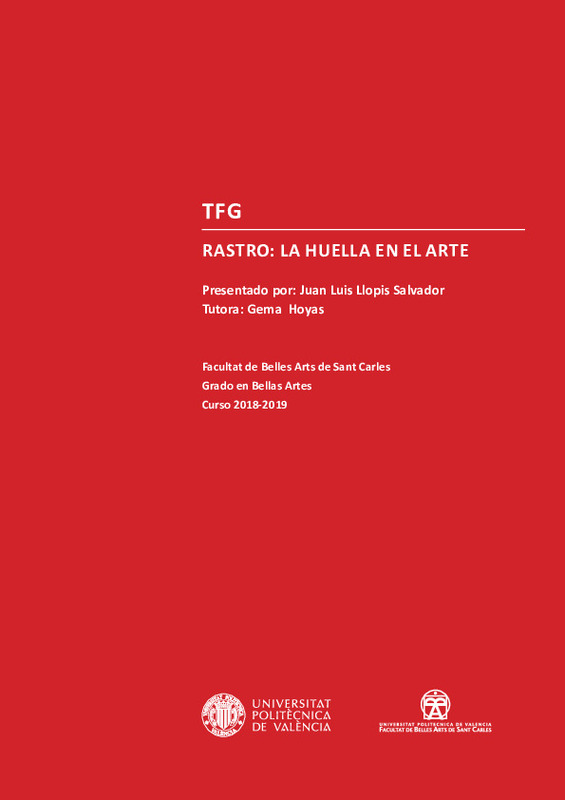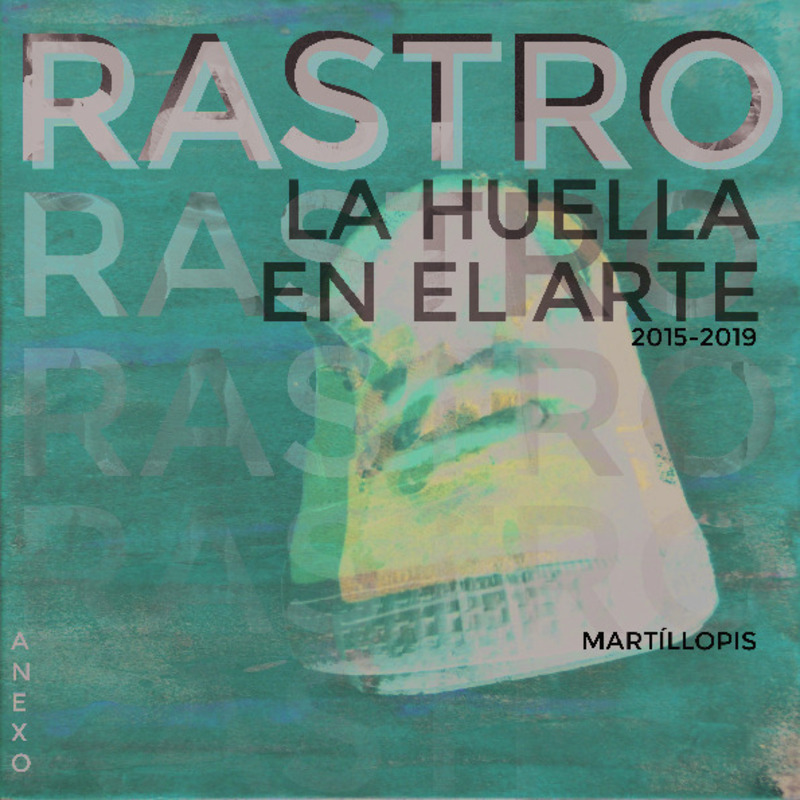JavaScript is disabled for your browser. Some features of this site may not work without it.
Buscar en RiuNet
Listar
Mi cuenta
Estadísticas
Ayuda RiuNet
Admin. UPV
RASTRO: la huella en el arte
Mostrar el registro sencillo del ítem
Ficheros en el ítem
| dc.contributor.advisor | Hoyas Frontera, Gema
|
es_ES |
| dc.contributor.author | Llopis Salvador, Juan Luis
|
es_ES |
| dc.date.accessioned | 2019-04-12T11:34:39Z | |
| dc.date.available | 2019-04-12T11:34:39Z | |
| dc.date.created | 2019-03-28 | |
| dc.date.issued | 2019-04-12 | es_ES |
| dc.identifier.uri | http://hdl.handle.net/10251/119326 | |
| dc.description.abstract | el nuevo título, "RASTRO": la huella en el arte, hace referencia al hecho de que por una parte el arte de cada época es como el rastro de la misma, y por tanto su estudio nos ayuda a comprender la cultura de esa sociedad y por otro lado, dentro de nuestra elección artística, hemos apostado por la huella sociológica a partir de un objeto usado o encontrado (detritus), entendiendo este esta como rastro de nuestra sociedad de consumo. Este trabajo aborda el análisis teórico y plástico del proyecto artístico RASTRO, la huella en el arte. Siempre nos ha parecido interesante observar el registro que deja lo artístico a lo largo de la historia del arte, muy evidente en el pasado, y que en la actualidad, con la llegada de lo efímero, parte de él tan sólo se concreta, como único rastro, de manera fotográfica y documental. También es verdad que en el pasado, la época y el entorno en que se realiza la obra marcará y concretará las posibilidades del artista. Ahora bien, con el comienzo del siglo XX se multiplicarán las posibilidades y el objeto artístico pasará de ser algo representado a ser presentado, como algo completamente independiente e incluso artístico en sí mismo llegando a lo conceptual, a la idea como objeto. Y este es el relato teórico que queremos desarrollar en este TFG, a partir del ready-made, un objeto usado y/o encontrado que, por otro lado, nos ayude a evidenciar la sociedad del momento. El elemento plástico que servirá de nexo de unión en este proyecto se irá desarrollando a partir de ciertos ¿detritus¿, rastros de nuestros hábitos de consumo. Cuando hablamos de rastro, no solo nos referimos al objeto, lo visible, sino más bien a lo que hay detrás, a lo no-visible, la idea. PALABRAS CLAVE: Rastro; Huella; Ready-made; Relato sociológico; Idea; Detritus. | es_ES |
| dc.description.abstract | The new title, " RASTRO: the trace in art", refers to the fact that on the one hand the art of each time is like the trace of it, and therefore its study helps us to understand the culture of that society and on the other hand, within our artistic choice, we have opted for the sociological trace from an object used or found (detritus), understanding this as a trace of our consumer society. This work deals with the theoretical and plastic analysis of the artistic project RASTRO, the trace in art. We have always found it interesting to observe the trace left by the artistic throughout the history of art, very evident in the past, and that today, with the arrival of the ephemeral, part of it only becomes concrete, as unique trace, in a photographic and documentary way. It is also true that in the past, the time and environment in which the action takes place will mark and concretize the artist¿s possibilities. However, with the beginning of the twentieth century the possibilities will multiply and the artistic object will go from being something represented to being presented as something completely independent and even artistic in itself reaching the conceptual, the idea as an object. And this is the theoretical concept that we want to develop in this TFG from the ready-made, an object used and/ or found that, on the other hand, helps us to show the society of the moment. The plastic element that will serve as a link in this project will be developed from certain ¿detritus¿, traces of our consumer society. When we speak of ¿Rastro¿, we refer not only to the object, the visible, but rather to what is behind, to the non-visible, the idea. KEYWORDS: Trail; Trace; Ready-made; Sociological concept; Idea; Detritus | es_ES |
| dc.language | Español | es_ES |
| dc.publisher | Universitat Politècnica de València | es_ES |
| dc.rights | Reserva de todos los derechos | es_ES |
| dc.subject | Rastro | es_ES |
| dc.subject | Ready-made | es_ES |
| dc.subject | Transferir | es_ES |
| dc.subject | Relato sociológico | es_ES |
| dc.subject | Detritus | es_ES |
| dc.subject | Trail | es_ES |
| dc.subject | Transfer | es_ES |
| dc.subject | Sociologyc narrative | es_ES |
| dc.subject.classification | ESCULTURA | es_ES |
| dc.subject.other | Grado en Bellas Artes-Grau en Belles Arts | es_ES |
| dc.title | RASTRO: la huella en el arte | es_ES |
| dc.type | Proyecto/Trabajo fin de carrera/grado | es_ES |
| dc.rights.accessRights | Abierto | es_ES |
| dc.contributor.affiliation | Universitat Politècnica de València. Departamento de Escultura - Departament d'Escultura | es_ES |
| dc.contributor.affiliation | Universitat Politècnica de València. Facultad de Bellas Artes - Facultat de Belles Arts | es_ES |
| dc.description.bibliographicCitation | Llopis Salvador, JL. (2019). RASTRO: la huella en el arte. http://hdl.handle.net/10251/119326 | es_ES |
| dc.description.accrualMethod | TFGM | es_ES |
| dc.relation.pasarela | TFGM\101070 | es_ES |
Este ítem aparece en la(s) siguiente(s) colección(ones)
-
BBAA - Trabajos académicos [5086]
Facultad de Bellas Artes







